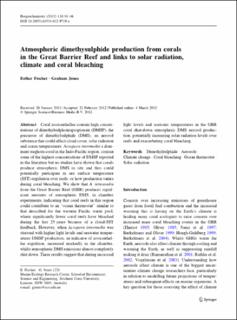Please use this identifier to cite or link to this item:
https://doi.org/10.21256/zhaw-3826| Publication type: | Conference paper |
| Type of review: | Peer review (publication) |
| Title: | Atmospheric dimethylsulphide production from corals in the Great Barrier Reef and links to solar radiation, climate and coral bleaching |
| Authors: | Fischer, Esther Jones, Graham |
| DOI: | 10.21256/zhaw-3826 10.1007/s10533-012-9719-y |
| Published in: | Biogeochemistry |
| Proceedings: | Special Issue of the 5th International Symposium on Biological and Environmental Chemistry of DMS(P) and Related Compounds, Goa, India, 19-22 October 2010 |
| Volume(Issue): | 110 |
| Issue: | 1–3 |
| Page(s): | 31 |
| Pages to: | 46 |
| Conference details: | 5th International Symposium on Biological and Environmental Chemistry of DMS(P) and Related Compounds, Goa, India, 19-22 October 2010 |
| Issue Date: | 2012 |
| Publisher / Ed. Institution: | Springer |
| ISSN: | 1573-515X 0168-2563 |
| Language: | English |
| Subjects: | Aerosol; Coral bleaching; Dimethylsulphide |
| Subject (DDC): | 577: Ecology |
| Abstract: | Coral zooxanthellae contain high concentrations of dimethylsulphoniopropionate (DMSP), the precursor of dimethylsulphide (DMS), an aerosol substance that could affect cloud cover, solar radiation and ocean temperatures. Acropora intermedia a dominant staghorn coral in the Indo-Pacific region, contain some of the highest concentrations of DMSP reported in the literature but no studies have shown that corals produce atmospheric DMS in situ and thus could potentially participate in sea surface temperature (SST) regulation over reefs; or how production varies during coral bleaching. We show that A. intermedia from the Great Barrier Reef (GBR) produces significant amounts of atmospheric DMS, in chamber experiments, indicating that coral reefs in this region could contribute to an ‘‘ocean thermostat’’ similar to that described for the western Pacific warm pool, where significantly fewer coral reefs have bleached during the last 25 years because of a cloud-SST feedback. However, when Acropora intermedia was stressed with higher light levels and seawater temperatures DMSP production, an indicator of zooxanthellae expulsion, increased markedly in the chamber, whilst atmospheric DMS emissions almost completely shut down. These results suggest that during increased light levels and seawater temperatures in the GBR coral shut-down atmospheric DMS aerosol production, potentially increasing solar radiation levels over reefs and exacerbating coral bleaching. |
| Further description: | Erworben im Rahmen der Schweizer Nationallizenzen (http://www.nationallizenzen.ch) |
| URI: | https://digitalcollection.zhaw.ch/handle/11475/7566 |
| Fulltext version: | Published version |
| License (according to publishing contract): | Licence according to publishing contract |
| Departement: | Life Sciences and Facility Management |
| Organisational Unit: | Institute of Natural Resource Sciences (IUNR) |
| Appears in collections: | Publikationen Life Sciences und Facility Management |
Files in This Item:
| File | Description | Size | Format | |
|---|---|---|---|---|
| Fischer-Jones2012_Article_AtmosphericDimethysulphideProd.pdf | 796.03 kB | Adobe PDF |  View/Open |
Show full item record
Fischer, E., & Jones, G. (2012). Atmospheric dimethylsulphide production from corals in the Great Barrier Reef and links to solar radiation, climate and coral bleaching [Conference paper]. Biogeochemistry, 110(1–3), 31–46. https://doi.org/10.21256/zhaw-3826
Fischer, E. and Jones, G. (2012) ‘Atmospheric dimethylsulphide production from corals in the Great Barrier Reef and links to solar radiation, climate and coral bleaching’, in Biogeochemistry. Springer, pp. 31–46. Available at: https://doi.org/10.21256/zhaw-3826.
E. Fischer and G. Jones, “Atmospheric dimethylsulphide production from corals in the Great Barrier Reef and links to solar radiation, climate and coral bleaching,” in Biogeochemistry, 2012, vol. 110, no. 1–3, pp. 31–46. doi: 10.21256/zhaw-3826.
FISCHER, Esther und Graham JONES, 2012. Atmospheric dimethylsulphide production from corals in the Great Barrier Reef and links to solar radiation, climate and coral bleaching. In: Biogeochemistry. Conference paper. Springer. 2012. S. 31–46
Fischer, Esther, and Graham Jones. 2012. “Atmospheric Dimethylsulphide Production from Corals in the Great Barrier Reef and Links to Solar Radiation, Climate and Coral Bleaching.” Conference paper. In Biogeochemistry, 110:31–46. Springer. https://doi.org/10.21256/zhaw-3826.
Fischer, Esther, and Graham Jones. “Atmospheric Dimethylsulphide Production from Corals in the Great Barrier Reef and Links to Solar Radiation, Climate and Coral Bleaching.” Biogeochemistry, vol. 110, no. 1–3, Springer, 2012, pp. 31–46, https://doi.org/10.21256/zhaw-3826.
Items in DSpace are protected by copyright, with all rights reserved, unless otherwise indicated.